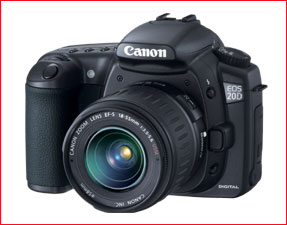
When I receive a pre-production camera for testing, as was the case in August, 2004 with the Canon 20D, it is always a mixed pleasure. Naturally it’s enjoyable to get to use the latest technology, and see how it performs. But it’s also somewhat frustrating, because invariably one or more things is missing. Sometimes the image quality hasn’t been fine tuned; Often there is no manual, or other documentation. And, frequently there is no image processing software. So, when an exciting new camera starts to ship it’s always a treat to get to use it in the field in a real-world shooting situation, and to put every aspect of it to the test.
As a sometime equipment reviewer, for this site as well as forPhoto Techniquesmagazine, where I’m a Contributing Editor, I naturally get products for testing directly from the manufacturer. But, regardless of what some people think, these always have to be returned (usually quickly), and when it comes time to buy something I have to place my order with a dealer and wait, just like everyone else. So, when the 20D and new 17-85mm EFS IS lens which I had on order showed up at my dealer literally 3 hours before I was to head for the airport to catch a flight to Paris, needless to say, I was both pleased and relieved.
A 20D in Paris
No, this isn’t going to be about shooting in Paris. As wonderful as that city is, this report will be about the equipment, how it handled and how it performed in the field. Interestingly, virtually all of my judgments about this camera from when I tested a pre-production sample unit hold up. Most impressive (for Canon owners at least) will be the almost instant start-up of the 20D. This allows one to leave the camera turned on almost all the time (except when it’s in a bag), with the auto-turn-off time set to something like 2 or 4 minutes, to save battery. Then, when a shot presents itself, just touch the shutter release and the camera is operational in an instant.
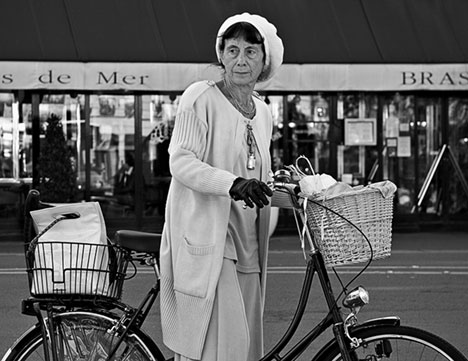
Shopping. Paris, France. September, 2004
Canon 20D with EFS 17-85mm f/5.6 IS lens @ ISO 200
I found the higher resolution of the 20D over the 10D to offer a very worthwhile increase in the amount of cropping that’s possible while still permitting adequate print sizes. Some photographers are cynical about ever-increasing pixel count, and it’s true that for many for whom an A4 (8X10") print is considered "big", higher pixel count may well be regarded as redundant. But for those that want A3 prints, as well as those who find that they need to crop a shot because they couldn’t get close enough, 8 Megapixel files will be most welcome.
Of course prior to the 20D, and based on experience with results from 8MP digicams (all of which use a Sony sensor), there was skepticism as to whether such dense pixel counts could retain the low noise characteristics that we’ve become used to. The answer is that not only is this the case, but in fact, while I found that the 10D and 20D measured similarly at high ISOs, the 20D displayed lowervisiblenoise. In my experience the 20D joins the Canon 1D Mark II in being the lowest noise camera that I’ve ever tested. Consequently, I didn’t hesitate to use ISO 1600, and even "H", which is ISO 3200 – set via a custom function, when needed.
I found this to be especially useful when shooting with the relatively slow Canon 17-85mm f/4-f/5.6 IS lens. In the past, shooting on the streets of Paris before dawn, I would have used an f/1.4 or at most an f/2 lens. But when IS0 1600 provides results that look better than film at ISO 400, and Image Stabilization provides an extra 2 stops of hand-holdability, shooting in adverse light conditions with a slow zoom lens become possible, and even pleasurable.
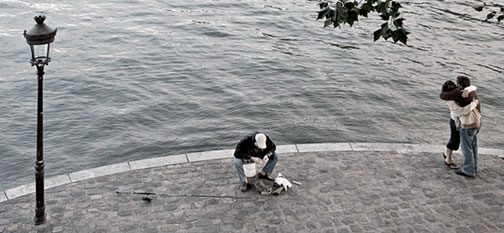
A Seine Morning. Paris, France. September, 2004
Canon 20D with EFS 17-85mm f/5.6 IS lens @ ISO 1600
Image intentionally desaturated
Below is an example of what this combination of technologies – I.S. plus low noise at high ISO – can do. I am able to see detail in the shadows that was invisible to the naked eye. And, while noiseisvisible at 100%, on an A3-sized print it hardly is worth applying any noise reduction. Also, the value of being able to hand-hold an SLR at 1/13th of a second without blurring is not to be underestimated. Though it doesn’t look it, this shot was taken at about 6am, well before sunrise.
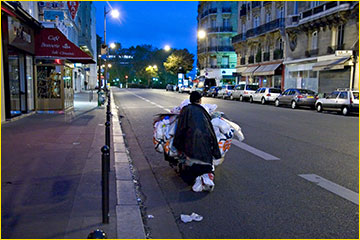

Canon 20D with EFS 17-85mm f/5.6 IS lens @ ISO 3200
I didn’t use the 20D’s 5FPS burst capability much. When doing street shooting I much prefer to watch the action, and then judge the peak moment. But, the few times that I did use it, I appreciated the large RAW buffer, and ability to continue shooting at the rate of about 1FPS, even when the buffer is full. The 20D’s shutter responsiveness, while not in quite the same league as a 1 Series Canon camera, is still quick enough so that once one gains a bit of experience with it, capturing peak action should be straightforward.
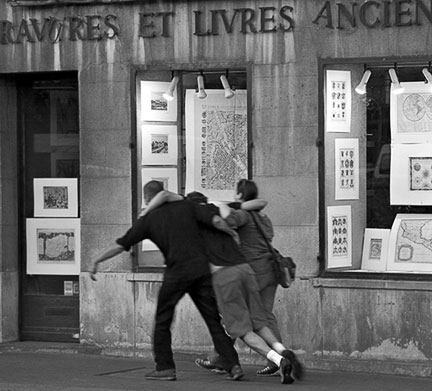
The Morning After The Night Before. Paris, France. September, 2004
Canon 20D with EFS 17-85mm f/5.6 IS lens @ ISO 800
I was less happy with the sound of the 20D’s shutter. It has a harsher pitch than that of the 10D and its predecessors, and thus can be more audible in undesired situations. While I don’t expect the stealth shutter sound of an M Leica, or better yet the total silence of a digicam, I found it to be subjectively one of the acoustically noisier cameras that I’ve recently used. The above photograph was taken before dawn on a Sunday morning, and in the narrow confines of a quiet Parisian street the shutter sounded like a loud clap, immediately attracting the attention of at least two of the three people I was photographing. (The third one wouldn’t have heard the trumpet of the angel of death if it had been blowing in his ear.)
In my20D preview reportI had been critical of the viewfinder, finding it to be somewhat coarser than that of the 10D. In the end this is a comparative rather than a practical concern. Reduced frame DSLRs have inherently small and dim viewfinders when compared to film bodies, or full-frame digital camera like the 1Ds, and there’s little point in making an issue of it.
Without going into a full critique of Canon’s control ergonomics, (better than some, but not as good as they could be), there were a few things that stand out. The fact that the hand-grip no longer has finger grooves is missed, and while it was probably done to reduce the camera’s size, the result is a slightly less sure grip. Indeed for some people the 20D may in fact be too small, at least in terms of height without the accessory battery grip. That’s why the omission of the finger grooves is to my mind an ergonomic defect.
I liked the change to having the rear control wheel activation now on the power switch. It never made much sense as a stand-alone lever, and the joystick control, which now takes its place, is a much welcome feature. It also makes choosing a specific focus point, or zooming to a specific part of the screen on playback, quick and convenient.
Autofocus on the 20D is so much improved over the 10D as to seem like from another generation of camera, which it clearly is. It is fast, precise and reliable. Anyone who has difficulty getting sharply focused images with this camera, in almost any light, needs to consider taking up another hobby or profession.
Battery life was found to be excellent. I changed the battery before leaving, till the charger light stopped flashing, and then, because I was in a hurry to leave for the airport, popped it in the camera. According to the manual I should have changed it for at least an additional hour. By the fourth day, after shooting a total of some 400 frames, I noticed that the power bar on the LCD had dropped one notched, so I recharged the battery, just to be sure. I’ll leave it to one of the more conscientious camera testers to provide a battery run-down test, but needless to say, battery life will be found to be quite excellent.
The 17-85mm f/4 – f.5.6 EFS IS lens turned out to a very usable lens – ideal for the kind of shooting that I was doing. On a 1.6X factor camera like the 20D it provides the equivalent of 28-135mm focal lengths. This covers the most common range used by most people. (I’ll have a DxO lab test of this lens in the near future). And, as an aside, (because I was shooting in Paris), its worth bearing in mind thatHenri Cartier Bressonnever used a focal length longer or wider than these. The lens’ Image Stabilization capability was appreciated, as always, even when shooting at wide angle settings.
I was annoyed with Canon though that this lens does not come with a shade. I hadn’t realized this when I picked up the camera and lens, and found myself working all week without one, something that I never do. Though it’s not an "L" series lens, at this price point Canon should include both a shade and soft pouch.
____________________________________________________________________________________
The Bug
Yes Virginia – there is a firmware bug. On my second day shooting with the 20D I changed lenses and then found that the camera froze. The shutter wouldn’t fire, and top-panel LCD remained live even when the power switch was turned off. In other words, the camera needed to be rebooted by removing the battery for a few moments. It was fine from then on, and I haven’t had a repeat since. But when I went online that evening I saw discussion on this site’s forum as well as elsewhere that other early purchasers were experiencing the same thing. It is not clear as this is being written exactly what is causing the problem, But I hope that Canon will track it down and issue a firmware update before too long. Let’s also hope that this isn’t a sign that Canon has engaged Microsoft to write its firmware.
____________________________________________________________________________________
Conclusion
With the 20D, it’s my perception that, for Canon lens owners at least, the DSLR has reached maturity. Since the D30 of the year 2000, and the D60 and 10D since, Canon’s approach has been to concentrate on continuing improvements to image quality. But when judged strictly as cameras, each previous model left something to be desired, whether it was autofocus speed, shooting speed, turn-on lag or other factors. If one wanted a high performance camera one needed to step up to one of the much more expensive 1 Series bodies. But with the 20D though, I feel that this is no longer the case.
One can quibble about some minor issues, but whether one is a pro or an amateur, the 20D will be found to be a highly competent camera in virtually every aspect of its performance and capabilities. As for how it compares to offerings from other manufacturers, I’ll leave that issue to other reviewers, and to the denizens of the discussion forums who love those pointless debates. But clearly with the 20D, build quality, features, performance and image quality have all come together into a camera that will satisfy, and largely exceed, the needs of most photographers. And with the new generation of ultra-wide angle zooms (reviews coming soon), there isn’t even an issue of reduced wide-angle capability to deter prospective buyers.
Perfection? Hardly. But, the 20D is definitely a worthwhile upgrade for anyone with a previous generation Canon DSLR, and many a pro will find that while it doesn’t have the ruggedness and weatherproofing of the 1D MKII, and the viewfinder is also smaller and dimmer, the 20D offers much of the performance of its bigger brother at a third of the price. For anyone just entering the digital SLR fray, the Canon 20D, because of its high image quality, excellent performance, and moderate price, may well be the camera to remove a film diehard’s final excuses.
Sept, 2004
____________________________________________________________________________________
Update – October 6, 2004
Canon has just made availableFirmware Update 1.0.5for the newCanon 20D. This update fixes the lock-up problem that some users where experiencing. Note that this update also addresses the bug which caused Update V1.0.4, released briefly last week, to fry some cameras. I have installed this new update without incident. It only takes a few minutes and you should have no trouble, as long as you follow the directions carefully. Cudos to Canon for addressing these problems promptly.
You May Also Enjoy...
Nested Doorways and Windows
Please use your browser's BACK button to return to the page that brought you here.
